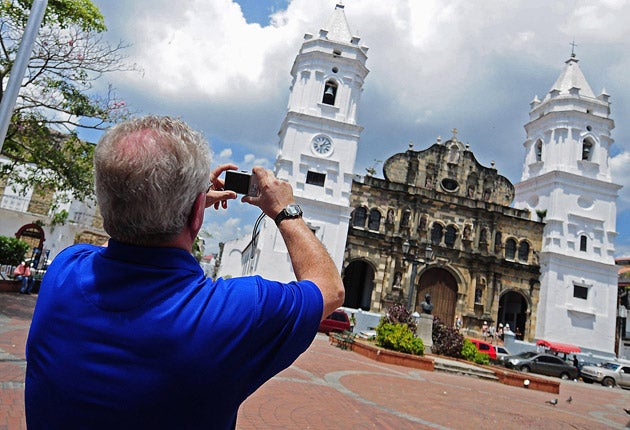Central America: Tricky territory? Not these days
New links and routes are making it easier to get around Central America. Mark Rowe reports

For a part of the world where you can see the Caribbean and the Pacific Ocean in the same day, and explore pre-Columbian ruins and listen to unusual birdsong in cloud forests, Central America remains a surprisingly low-key destination. But all that is starting to change.
Despite the global recession, the region – which includes Belize, Costa Rica, El Salvador, Guatemala, Honduras, Nicaragua and Panama – has seen an increase in visitor numbers and a succession of infrastructure developments that will make it easier to get around than ever before are nearing completion.
Partly in recognition of these trends, major airlines now fly more frequently to the region, and without laborious flight itineraries via the southern United States or Mexico. This month, British Airways (ba.com) will start direct twice-weekly flights from Gatwick to Cancun in Mexico's Yucatan peninsula, shortening the time required to reach neighbouring Belize. Last month, Iberia (Iberia.com) launched a direct service four times a week from Madrid to Guatemala City and San Salvador, the capital of El Salvador.
From San Salvador, travellers will be able to take connecting flights to other destinations such as Managua in Nicaragua and the Honduran cities of San Pedro Sula and Tegucigalpa. Iberia has also just launched a direct service to Panama City from Madrid, opening up the south of the region to visitors.
Meanwhile, more inter-regional flights are being laid on. Taca airlines (tacaairlines.co.uk) is offering new routes joining Central and South America and the US. The airline, which has hubs in San Jose, Costa Rica, San Salvador and El Salvador, has flights to Colombia from San Jose and to Orlando from Guatemala City.
New hotels in Panama include the Hotel Riu Panama Plaza (riuplaza .com), in the heart of Panama City's financial district, which opened in September, and the Breezes Resort & Spa Panama (breezes.com), in the Santa Clara region, two hours from Panama City on the Pacific coast. Elsewhere, new openings include the 18-room Hotel Boutique Contempo (contempohb.com) in Nicaragua's capital Managua, and the Hotel Camino Real (caminorealantigua .com.gt) in the colonial city of Antigua Guatemala.
The conversion of the Pacific corridor, which runs for 2,000 miles from Panama to Mexico, into a reliable highway by 2015 should remove and reduce bottlenecks. A new highway linking San Jose and Puntarenas on the Gulf of Nicoya in Costa Rica now saves travellers up to an hour on the journey. Work on a new airport at San Juan in southern Nicaragua ends next summer and will have capacity for 18-seater planes. But the biggest project of all is the eight-year, $5bn expansion of the Panama Canal.
Some of these projects are funded by major international donors such as the World Bank; others are driven by a realisation of the value of the tourist dollar, and there is also a wider local drive for greater integration, known as the Mesoamerican Project, which, among other things, is likely to make border crossings less complicated. "Tourism plays such a large part in their economies that they are looking to invest in services, flight routes, roads, restaurants and other facilities for tourists," said Laura Rendell-Dunn of Journey Latin America. "The countries are smaller than in South America, so they don't have the extensive bus systems or flight routes, but the transport system is improving in leaps and bounds. The direct flight to Panama will make a huge difference. Before this you had to go via Guatemala City or San Jose in Costa Rica.
"Each country is different. Many have Mayan ruins that have yet to be excavated, or huge temples that peep through the tree canopy. And, because there are still not many tourists, you feel like you are heading off the beaten track while, for honeymooners, there are a lot of boutique hotels overlooking the Caribbean."
The numbers for travellers to the region have been robust during the past couple of years. JLA sent 3,100 passengers in 2009 compared with 1,600 in 2006. According to data from Latina Marketing, the number of visitors to Central America increased by 6 per cent to 1.5 million in 2009. Of these, 151,000 were from Europe, a rise of 4 per cent year on year, and 19,900 were from the UK.
"Belize has a good road network and road signs that make using a hire car a doddle, but there is also a comprehensive flight network that links all the major lodges. You can now charter a two-seater for a little under $350 to take you anywhere," said Rafe Stone, JLA product manager for Central America.
"Smaller projects, such as a fast boat out to the Bay Islands from La Ceiba in Honduras, make for efficient transfers between the islands and the mainland. El Salvador has some of the best roads in the region, with freeways enabling you to get from one side of the county to the other very swiftly, and there have been improvements in Nicaragua on roads in rural areas like Matagalpa," he added.
"Of course, the dirt tracks and wooden dugouts will remain and will always be part of the fun when travelling in this part of the world."
Subscribe to Independent Premium to bookmark this article
Want to bookmark your favourite articles and stories to read or reference later? Start your Independent Premium subscription today.

Join our commenting forum
Join thought-provoking conversations, follow other Independent readers and see their replies